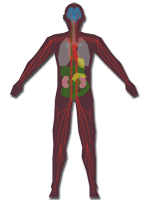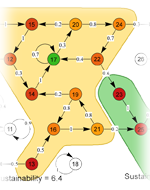Projects
Below you will find information about projects completed, in progress, or under development through the Complexity Research Corporation. This organization was established to act as a vehicle for unifying a diverse team of professors, researchers, engineers, artists, etc. to facilitating working together on problems that would be difficult to collaborate on through other means. If you would like more information about any of these projects, and are possibly interested in joining our team to work on one or more of them, please feel free to contact us.
Intensive Care Unit Testbed

The human body is a clear example of a complex system, yet most approaches to model it assume it operates according to a set of equations or top-down rules. Instead of treating the outcome of tissue functions and interactions like car diagnostics or other engineered systems, we are building the human body and its system functions from the bottom up. In collaboration with the Mayo Clinic, our intensive care patient simulator will act as both a testbed environment for interventions, but also an exploratory tool for knowledge gaps in our understanding of body function. Because the model takes individual tissues or organs as the agents and defines all behaviors and properties at that level, the operation of the body under homeostasis, malfunction, injuries, infections, and interventions can be seen and understood as emerging from these organ/tissue properties and behaviors.
Predictive Analytics through Dynamical Properties

Statistical approaches to data projection make the assumption that the future will unfold much like the past. The modeling approach identifies mechanisms that are capable of generating the past data, and then uses them to generate future data. Our Dynamical Properties approach combines these by matching contingency patterns in data to form a more complete picture of system behavior. This domain-agnostic technique can uncover features such as tipping points, robust states, and path dependencies of any time-series dataset, and using our unique system representation make actionable predictions of non-linear, sensitive, and uncertain system behavior. We are currently working on applications to medical records, financial market data, flight and wind tunnel tests, and others.
Toolkits for Analyzing Hypergraphs and k-partite Networks

Network theory has made tremendous progress in forwarding our understanding of systems across all domains, though most of this has been done with simple binary networks. Though there are numerous examples of both hypergraphs and k-partite graphs in the early literature, these representations have been largely relegated to the back burners. Partly this is because simple binary networks are still yielding valuable insights, and partly this is because they are more complicated structures requiring more complicated analysis techniques and algorithms. However, we are already seeing examples of systems being represented as binary graphs despite the inappropriateness of this approach. Our response is to push forward the construction of toolkits capable of handling more sophisticated network structures; and in many cases the techniques and algorithms themselves still need to be developed to accomplish this.
Best Practices for Agent-Based Modeling

The modeling of complex systems through agent-based models has only been a possibility for 30 years, and only within the past decade have reasonably sophisticated models been widely practical. Partly due to complexity theory's interdisciplinary roots, researchers come to computational modeling with different assumptions and needs. Unfortunately the combination of being new and broad has left agent-based modeling without a solid foundation of technical approaches and when to use which ones. In collaboration with our many modeling specialist partners, we are compiling a guidebook of best practices in agent-based modeling. Not a textbook per se, but rather a collection of reasons for utilizing one method rather than another and under what conditions.

